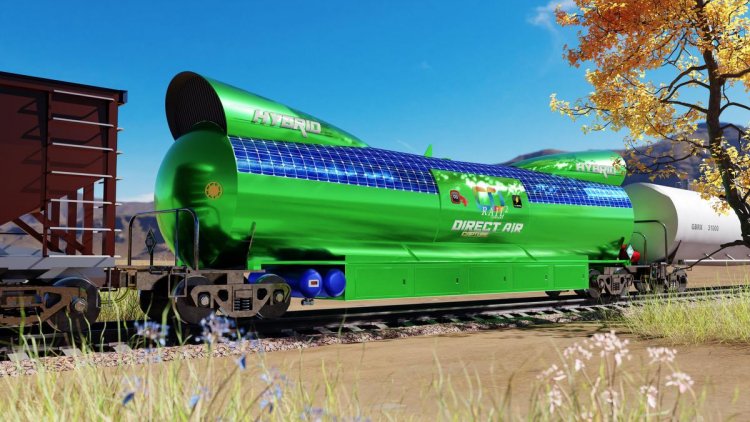How greened trains could suck CO2 out of the air
Trains of the future could be scrubbing the air of carbon dioxide rather than belching it out of their smokestacks, proposes new research, and that could go a long way to helping mitigate the climate change crisis.In a paper published Wednesday in the energy research journal Joule, researchers from Canada, the U.S. and the U.K. said that modified rail cars, placed within trains already on the rails today, could help alleviate climate change by removing CO2 from the air as the train rumbles along.Furthermore, they say, the technology that accomplishes this could be powered entirely by making use of the energy generated by the braking of trains, a source that has gone largely unused until now.It’s a discovery that comes at a time that University of Toronto Professor Geoffrey Ozin, one of the paper’s co-authors, calls “a Woodstock moment” — a sea change, a moment when the world is looking for ways to ease the impact of climate change and buying into systems for capturing carbon from the atmosphere.“A lot of people are going to get on this train,” he said. “Ride the train; save the world.”In the paper, “Rail-Based Direct Air Carbon Capture,” researchers from the U of T and the University of Sheffield along with U.S.-based start-up CO2Rail estimate that in the short term, a single rail car equipped with Direct Air Capture (DAC) technology could remove 3,000 tonnes of carbon dioxide annually from the atmosphere, a number which could double in the medium term as technology improves.“We have designed technology that utilizes special purpose rail cars that take in ambient air and remove the carbon dioxide and release pretty close to CO2-free air using the regenerative braking energy of a train,” said CO2Rail chief technical officer Eric Bachman.By 2050 — based on a projection that assumes 400,000 of those DAC rail cars will be in service — researchers estimate they could remove 2.9 gigatons of CO2 from the atmosphere annually. (Trains’ own carbon footprints vary depending on their fuel source; in North America, diesel is predominant.)That date, 2050, is important for a few reasons. The goal of the Paris Agreement — a binding international treaty on climate change adopted by more than 190 countries — is to limit global warming to well below two degrees Celsius (preferably to 1.5 degrees) compared to pre-industrial levels.Doing that, according to a 2017 report from the United Nations, would require the removal of 10 gigatons annually by 2050. So, if it were to happen, the 400,000-strong armada of DAC rail cars on the tracks of the world would go almost 30 per cent of the way to satisfying that goal.The other reason that 2050 is significant is because of a late June decision by rail industry leaders in Europe to triple current usage of high-speed rail by 2050, a proposal that would certainly require the construction of tens of thousands of kilometres of new railroad lines as well as cars to ride them. DAC technology would use air scoops to collect air as the train moves along. A carbon capture system would remove the carbon dioxide from that air and vent the mostly CO2-free air at the back of the car.The collected CO2 would be concentrated and stored in liquid form, after which it could be distributed as feedstock — a source of carbon for various manufacturing processes — or sent to landfill sites to be sequestered in the earth.The CO2-scrubbing technology involved is, as a concept, not particularly new. But the idea of making it mobile, energy-independent, scalable and modular — you could attach several of the cars to one train — is.And the rail-based technology offers several advantages over land-based DAC systems, said Bachman.Collecting and removing carbon dioxide from the air is a relatively simple process. But to concentrate it into a liquid form in order to store it or repurpose it takes a large amount of energy.In land-based systems, that energy has to come either from the grid, or from renewable energy sources constructed along with the land-based DAC.“The granddaddy of all the advantages is that we don’t tie into the grid. We don’t have to plug in at night. We don’t have to build a solar farm,” said Bachman.Instead, he said, that power would come from the trains themselves.“Every time a train anywhere in the world stops or decelerates, they use this energy braking system,” he said. “Right now, that energy is just passed up to the top of the locomotive, converted to heat … and then a large fan blows that hot air out the top of the locomotive.”So it’s currently being wasted, but Bachman estimates the energy being produced by the world’s train brakes is 105 times that being produced by the Hoover Dam over a given period.“Imagine 105 Hoover dams. All that power being used to take carbon dioxide from the atmosphere. It’s enormous,” he said.As well as being grid-independent, since modified rail cars collect air passively, through scoops, they wouldn’t need to power fans to collect air, as land-based DAC facilities


Trains of the future could be scrubbing the air of carbon dioxide rather than belching it out of their smokestacks, proposes new research, and that could go a long way to helping mitigate the climate change crisis.
In a paper published Wednesday in the energy research journal Joule, researchers from Canada, the U.S. and the U.K. said that modified rail cars, placed within trains already on the rails today, could help alleviate climate change by removing CO2 from the air as the train rumbles along.
Furthermore, they say, the technology that accomplishes this could be powered entirely by making use of the energy generated by the braking of trains, a source that has gone largely unused until now.
It’s a discovery that comes at a time that University of Toronto Professor Geoffrey Ozin, one of the paper’s co-authors, calls “a Woodstock moment” — a sea change, a moment when the world is looking for ways to ease the impact of climate change and buying into systems for capturing carbon from the atmosphere.
“A lot of people are going to get on this train,” he said. “Ride the train; save the world.”
In the paper, “Rail-Based Direct Air Carbon Capture,” researchers from the U of T and the University of Sheffield along with U.S.-based start-up CO2Rail estimate that in the short term, a single rail car equipped with Direct Air Capture (DAC) technology could remove 3,000 tonnes of carbon dioxide annually from the atmosphere, a number which could double in the medium term as technology improves.
“We have designed technology that utilizes special purpose rail cars that take in ambient air and remove the carbon dioxide and release pretty close to CO2-free air using the regenerative braking energy of a train,” said CO2Rail chief technical officer Eric Bachman.
By 2050 — based on a projection that assumes 400,000 of those DAC rail cars will be in service — researchers estimate they could remove 2.9 gigatons of CO2 from the atmosphere annually. (Trains’ own carbon footprints vary depending on their fuel source; in North America, diesel is predominant.)
That date, 2050, is important for a few reasons. The goal of the Paris Agreement — a binding international treaty on climate change adopted by more than 190 countries — is to limit global warming to well below two degrees Celsius (preferably to 1.5 degrees) compared to pre-industrial levels.
Doing that, according to a 2017 report from the United Nations, would require the removal of 10 gigatons annually by 2050. So, if it were to happen, the 400,000-strong armada of DAC rail cars on the tracks of the world would go almost 30 per cent of the way to satisfying that goal.
The other reason that 2050 is significant is because of a late June decision by rail industry leaders in Europe to triple current usage of high-speed rail by 2050, a proposal that would certainly require the construction of tens of thousands of kilometres of new railroad lines as well as cars to ride them.
DAC technology would use air scoops to collect air as the train moves along. A carbon capture system would remove the carbon dioxide from that air and vent the mostly CO2-free air at the back of the car.
The collected CO2 would be concentrated and stored in liquid form, after which it could be distributed as feedstock — a source of carbon for various manufacturing processes — or sent to landfill sites to be sequestered in the earth.
The CO2-scrubbing technology involved is, as a concept, not particularly new. But the idea of making it mobile, energy-independent, scalable and modular — you could attach several of the cars to one train — is.
And the rail-based technology offers several advantages over land-based DAC systems, said Bachman.
Collecting and removing carbon dioxide from the air is a relatively simple process. But to concentrate it into a liquid form in order to store it or repurpose it takes a large amount of energy.
In land-based systems, that energy has to come either from the grid, or from renewable energy sources constructed along with the land-based DAC.
“The granddaddy of all the advantages is that we don’t tie into the grid. We don’t have to plug in at night. We don’t have to build a solar farm,” said Bachman.
Instead, he said, that power would come from the trains themselves.
“Every time a train anywhere in the world stops or decelerates, they use this energy braking system,” he said. “Right now, that energy is just passed up to the top of the locomotive, converted to heat … and then a large fan blows that hot air out the top of the locomotive.”
So it’s currently being wasted, but Bachman estimates the energy being produced by the world’s train brakes is 105 times that being produced by the Hoover Dam over a given period.
“Imagine 105 Hoover dams. All that power being used to take carbon dioxide from the atmosphere. It’s enormous,” he said.
As well as being grid-independent, since modified rail cars collect air passively, through scoops, they wouldn’t need to power fans to collect air, as land-based DAC facilities would.
And because they would be mobile, they skirt the questions of fixed infrastructure, zoning issues and environmental impact studies, meaning their numbers would be quickly scalable, said Bachman. The team has not yet developed a prototype, however.
Researchers said there is enough track in the global railway system that, if it were all arranged in a single line, it would reach to the moon and back twice. They also estimate a global population of rail cars at some seven million.



















:quality(85):upscale()/2024/09/04/734/n/1922283/9b8f37ec66d88cf7b7e084.15655484_.jpg)
